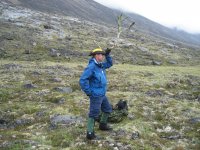Far from me to trow a monkey's wrench in the discussion here, but anybody looked at where Iqaluit is located?
It's on Baffin Island, across Hudson's strait from mainland Canada. How do you cross either the 165 Kms from Kangiksujuak, Qc (or for those who prefer - Nunavik, the official name of all of the Quebec Northern region) to the Kimmirut Inuit lands, or the 185 Km from Kilinik, Qc, to the southernmost point of Baffin island?
And how do you justify the hundreds of billions of dollars (you think getting six AOPS is expensive - think again) you would need to put thousands of kms of roads to link even just the few, far flung, barely inhabited (other than two or three towns such a Iqaluit, Tuktuyaktuk and Kuujuak, which have a few thousand inhabitants) towns of a few hundred people?
This various towns all have small, gravelled but maintained, and operational airports and usually, at least weekly service from mostly Twin Otters and slightly larger cargo planes. Air, supplemented by ships for heavy cargo during the summer season, is the only logical and logistically efficient system up there, and the only justifiable one.
Here's my dare: I dare anyone who has actually been up there for any reasonable amount of time, to argue otherwise.
Daftandbarmy: Norway, because of the Gulf stream, is not an arctic tundra and all these roads/railroads do not have to run in extreme cold weather, nor has to go over muskeg or permafrost ground. Finally, they have a population of 5.3 millions (because it is inhabitable) in 325,000 square kilometres, whereas the Canadian Arctic - in reverse figures - has only 120,000 inhabitants (mostly in the Yukon) spread over 3.5 millions square kilometres.





